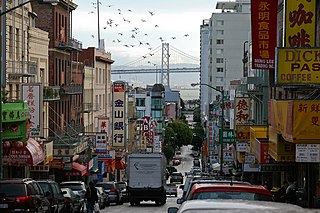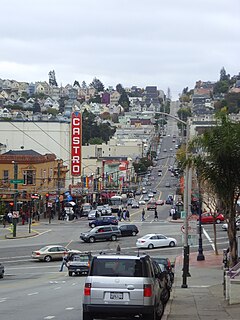
The Chinatown centered on Grant Avenue and Stockton Street in San Francisco, California, is the oldest Chinatown in North America and one of the largest Chinese enclaves outside Asia. It is also the oldest and largest of the four notable Chinese enclaves within San Francisco. Since its establishment in 1848, it has been important and influential in the history and culture of ethnic Chinese immigrants in North America. Chinatown is an enclave that has retained its own customs, languages, places of worship, social clubs, and identity. There are two hospitals, several parks and squares, numerous churches, a post office, and other infrastructure. Recent immigrants, many of whom are elderly, opt to live in Chinatown because of the availability of affordable housing and their familiarity with the culture. San Francisco's Chinatown is also renowned as a major tourist attraction, drawing more visitors annually than the Golden Gate Bridge.
The Asiatic Exclusion League was an organization formed in the early 20th century in the United States and Canada that aimed to prevent immigration of people of Asian origin.

The Chinatown neighborhood in Oakland, California(Chinese: 屋崙華埠), is traditionally Chinese which reflects Oakland's diverse Chinese American, and more broadly Asian American community. It is frequently referred to as "Oakland Chinatown" in order to distinguish it from nearby San Francisco's Chinatown. It lies at an elevation of 39 feet.

The Barbary Coast was a red-light district during the second half of the 19th and early 20th centuries in San Francisco that featured dance halls, concert saloons, bars, jazz clubs, variety shows, and brothels. Its nine block area was centered on a three block stretch of Pacific Street, now Pacific Avenue, between Montgomery and Stockton Streets. Pacific Street was the first street to cut through the hills of San Francisco, starting near Portsmouth Square and continuing east to the first shipping docks at Buena Vista Cove.

The history of Chinese Americans or the history of ethnic Chinese in the United States includes three major waves of Chinese immigration to the United States, beginning in the 19th century. Chinese immigrants in the 19th century worked in the California Gold Rush of the 1850s and the Central Pacific Railroad in the 1860s. They also worked as laborers in Western mines. They suffered racial discrimination at every level of society. The white people were stirred to anger by the "yellow peril" rhetoric. Despite provisions for equal treatment of Chinese immigrants in the 1868 Burlingame Treaty between the US and China, political and labor organizations rallied against "cheap Chinese labor."

The Page Act of 1875 was the first restrictive federal immigration law in the United States, which effectively prohibited the entry of Chinese women, marking the end of open borders. Seven years later, the 1882 Chinese Exclusion Act banned immigration by Chinese men as well.

The Black Cat Bar or Black Cat Café was a bar in San Francisco, California. It originally opened in 1906 and closed in 1921. The Black Cat re-opened in 1933 and operated for another 30 years. During its second run of operation, it was a hangout for Beats and bohemians but over time began attracting more and more of a gay clientele, and becoming a flashpoint for what was then known as the homophile movement, a precursor to the gay liberation movement that gained momentum in the 1960s.

The Forbidden City was a Chinese nightclub and cabaret in San Francisco, which was in business from 1938 to 1970, and operated on the second floor of 363 Sutter Street, between Chinatown and Union Square.
The Tavern Guild was an association of gay bar owners and liquor wholesalers that formed in 1962 in San Francisco, California and lasted until 1995.

Finocchio'sClub was a former nightclub and bar in operation from 1936 to 1999 in North Beach, San Francisco, California. The club started as a speakeasy called the 201 Club in 1929, located at 406 Stockton Street. In 1933, with the repeal of prohibition, the club moved upstairs and started to offer female impersonation acts; after police raids in 1936 the club relocated to the larger 506 Broadway location. Finocchio's night club opened June 15, 1936 and was located in San Francisco, California, above Enrico's Cafe at 506 Broadway Street in North Beach.
As of 2012, 21.4% of the population in San Francisco was of Chinese descent, and there were at least 150,000 Chinese American residents. The Chinese are the largest Asian American subgroup in San Francisco. San Francisco has the highest percentage of residents of Chinese descent of any major U.S. city, and the second largest Chinese American population, after New York City. The San Francisco Area is 7.9% Chinese American, with many residents in Oakland and Santa Clara County. San Francisco's Chinese community has ancestry mainly from Guangdong province, China and Hong Kong, although there is a sizable population of ethnic Chinese with ancestry from other parts of mainland China and Taiwan as well.

The lesbian, gay, bisexual and transgender (LGBT) community in San Francisco is one of the largest and most prominent LGBT communities in the United States, and is one of the most important in the history of American LGBT rights and activism alongside New York City. The city itself has, among its many nicknames, the nicknames "gay capital of the world", and has been described as "the original 'gay-friendly city'". LGBT culture is also active within companies that are based in Silicon Valley, which is located within the southern San Francisco Bay Area.
Crystal Jang is an LGBT activist based in San Francisco, California. She is one of the co-founders of the San Francisco Bay Area based organization, Asian Pacific Islander Queer Women and Transgender Community (APIQWTC), as well as community-based organization Older Asian Sisters in Solidarity (OASIS), which is now a part of APIQWTC.
This is a timeline of notable events in the history of non-heterosexual conforming people of Asian and Pacific Islander ancestry, who may identify as LGBTIQGNC, men who have sex with men, or related culturally-specific identities. This timeline includes events both in Asia and the Pacific Islands and in the global Asian and Pacific Islander diaspora, as the histories are very deeply linked.
API Equality – Northern California is an American social justice advocacy non-profit whose mission is to build the power and increase the visibility of the lesbian, gay, bisexual, transgender, and queer Asian Pacific Islander community.
The National Queer Asian Pacific Islander Alliance (NQAPIA) is an American federation of Asian American, South Asian, Southeast Asian. and Pacific Islander LGBTQ organizations. NQAPIA was formed in 2007, as an outgrowth of the LGBT APA Roundtable working groups at the 2005 National Gay Lesbian Task Force Creating Change Conference in Oakland, California. NQAPIA seeks to build the capacity of local LGBT AAPI organizations, invigorate grassroots organizing, develop leadership, and challenge homophobia, racism, and anti-immigrant bias. The organization "focuses on grass-roots organizing and leadership development."

Rev. Trinity Ordoña is a lesbian Filipino-American college teacher, activist, community organizer, and ordained minister currently residing in the San Francisco Bay Area. She is notable for her grassroots work on intersectional social justice. Her activism includes issues of voice and visibility for Asian/Pacific gay, lesbian, bisexual, transgender and queer individuals and their families, Lesbians of color, and survivors of sexual abuse. Her works include her dissertation Coming Out Together: an ethnohistory of the Asian and Pacific Islander queer women's and transgendered people's movement of San Francisco, as well as various interviews and articles published in anthologies like Filipino Americans: Transformation and Identity and Asian/Pacific Islander American Women: A Historical Anthology. She co-founded Asian and Pacific Islander Family Pride (APIFP), which "[sustains] support networks for API families with members who are LGBTQ," founded Healing for Change, "a CCSF student organization that sponsors campus-community healing events directed to survivors of violence and abuse," and is currently an instructor in the Lesbian, Gay, Bisexual and Transgender Studies Department at City College of San Francisco.
Barbara L. Voss is an American historical archaeologist. Her work focuses on cross-cultural encounters, particularly the Spanish colonization of the Americas and Overseas Chinese communities in the 19th century, as well as queer theory in archaeology and gender archaeology. She is an associate professor of anthropology at Stanford University.

Horacio N. Roque Ramírez was a Salvadoran American oral historian, writer and advocate whose work focused on LGBT Latino communities and the Central American experience in the United States. He was a faculty member in the Department of Chicana and Chicano Studies at the University of California, Santa Barbara.

The GLBTQ+ Asian Pacific Alliance, sometimes GAPA, is a 501(c)(4) non-profit social welfare organization that was incorporated in February 1988 in San Francisco, California, as a social support group for gay and bisexual Asian Pacific Islander (API) men. It engages in direct social, cultural and political advocacy, with a vision of "a powerful queer and transger Asian and Pacific-Islander (QTAPI) community that is seen, heard, and celebrated," and a mission "to unite our families and allies to build a community through advocacy, inclusion, and love."















